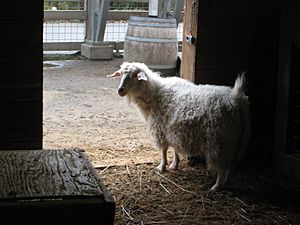Pygora goat facts for kids

The Pygora goat is a special kind of goat. It was created by mixing two other goat breeds: the Pygmy goat and the Angora goat. Pygora goats, along with Angora and Cashmere goats, are known as "fiber goats." This means they are raised mainly for their soft, wool-like fleece. Pygora goats can actually produce three different types of this valuable fleece!
Contents
How Pygora Goats Started
The Pygora goat was purposefully bred by a person named Katharine Jorgensen in Oregon City, Oregon. She wanted to create a new type of goat. In 1987, the Pygora Breeders Association was formed in the United States. This group helps register and promote Pygora goats. Today, a registered Pygora goat cannot have more than 75% Angora goat or 75% Pygmy goat in its family tree.
What Makes a Pygora Goat?
When a Pygmy goat and an Angora goat are first bred together, their babies are called "F1" crosses. These F1 crosses are not yet considered true Pygoras. However, you can breed these F1 crosses with other Pygora goats, or even back to pure Pygmy or Angora goats, to get true Pygora goats. This helps keep the breed strong, as long as the goats don't have more than 75% Pygmy or Angora blood.
Pygora Goat Features
Pygora goats usually live for about 12 to 14 years. They are mostly raised for their fiber, but people also show them in competitions, breed them, and sometimes even milk them.
A healthy Pygora goat's weight depends on if it's a male, female, or baby. Newborn Pygora kids (baby goats) weigh about 5 pounds. Female Pygora goats, called does, usually weigh between 65 and 75 pounds. Male Pygora goats (bucks) and wethers (desexed males) are heavier, weighing from 75 to 95 pounds.
Pygora fiber is very popular with artists. They use it for spinning yarn, knitting, crocheting, and weaving. This fiber is also used to make warm and soft clothing. Some Pygora goats can also be milked, producing about one liter of milk each day.
Interestingly, Pygora wethers often have better quality fiber than does or bucks. This is because wethers don't use their energy to have babies. While fiber production is their main purpose, some people also enjoy showing Pygora goats as a hobby. They show them at fairs, fiber shows, and in programs like 4-H. You can often see Pygora goats at events like the Oregon Flock and Fibre Festival (OFFF).
Types of Pygora Fleece
Registered Pygora goats can produce three main types of fleece:
- Type-A fleece: This fleece is like mohair. Its fibers are usually 6 inches or longer and hang in ringlets. It might have a silky outer layer of hair. These fibers are typically less than 28 micrometers thick.
- Type-B fleece: This fleece is a mix of the other two types. Its fibers are usually between 3 and 6 inches long. They are typically less than 24 micrometers thick.
- Type-C fleece: This fleece is very fine, like Cashmere wool. Its fibers are usually 1 to 3 inches long and less than 18.5 micrometers thick.
Pygora goats come in many different colors! You can find them in white, red, brown, black, gray, or even a mix of these colors.

